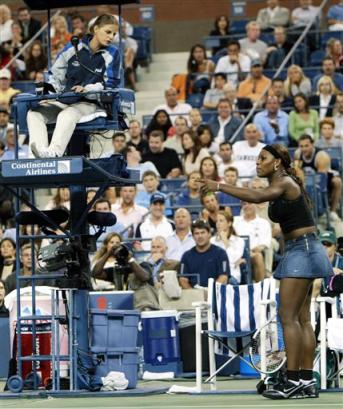
Serena Williams, right, argues with chair umpire Mariana Alves, left, during her match with Jennifer Capriati at the U.S. Open in New York, Tuesday, Sept. 7, 2004. Williams came up on the losing end when Alves overruled the line judge in the opening game of the third set. Capriati went on to win 2-6, 6-4, 6-4 and moved on to the semifinals.
With rain washing out live matches, people had a chance to see the officiating error that took a point from Williams and gave it to Capriati in the third set’s opening game Tuesday night.
That replay was everywhere. Well, everywhere, that is, but the chair umpire’s stand during the match itself.
And with no new results to talk about, the buzz around the National Tennis Center on Wednesday afternoon was about whether instant replay or other tools should be used to help make better rulings. There were at least two other questionable calls in the final game of Capriati’s 2-6, 6-4, 6-4 win.
“It was such a horrendous call. If I was closer to the court, I would have run onto the court,” said John McEnroe, who called the match on USA. “I’ve seen a lot of bad calls in my day, but I don’t think I’ve seen three bad calls in a set like that.”
Not surprisingly, given his “You cannot be serious!” reputation for on-court arguments, McEnroe favors adding some form of replay to tennis.
He would put limits, though, as there are in other pro sports, such as perhaps some sort of penalty for a wrong challenge. In the NFL, for example, a team can get up to three chances per game to question calls; if it loses a challenge, it forfeits a timeout. Limited forms of replay are used in the NHL and NBA, too, but baseball has never shown any interest in trying it.




